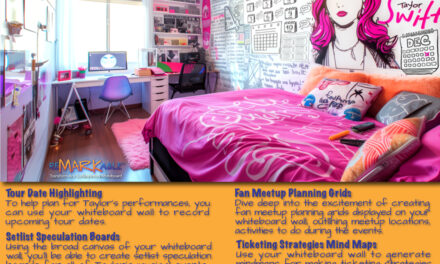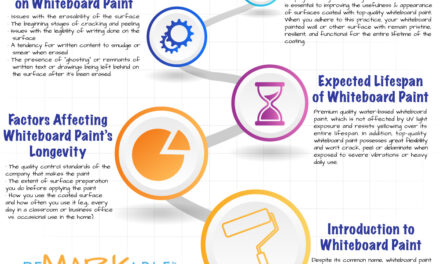Using the Right Roller on Whiteboard Paint
Whiteboard paint should only be applied with a high-quality microfiber paint roller cover that has a 1/4-inch or 3/8-inch nap
The smaller the nap on a roller cover is, the finer the type of surface that it’s capable of producing. The sizes of roller naps typically range from one-quarter inch to one inch, with the latter size most often being found on woven pile roller covers rather than on microfiber ones. Because they’re designed for use in paint and coating work requiring a smooth finish, microfiber roller sleeves are generally available in smaller naps to increase the smoothness and luster of the final painted or coated surface. And it is smoothness that you’re seeking when installing premium whiteboard coating so that writing and erasing on the finished surface will be easy to do, and you’ll experience no issues with uneven dry erase marker lines or incomplete erasing of your writings and drawings.
Being highly economical, microfiber roller covers can be used repeatedly, so they don’t have to be replaced often like regular roller covers made of woven pile fabric, and will thus come in handy when you have other coating or painting projects to do in the future. Microfiber rollers also have the capacity to absorb large amounts of paint or coating at one time. And this is desirable when applying premium whiteboard coating because the product is designed to be installed in one thick coat, not several thin coats, as with house paint and many other types of paints and coatings.
It’s possible to clean and reuse traditional woven pile paint roller covers, but they’re typically thrown away after a single-use, adding to the massive amounts of waste that occupy our already crowded landfills. In this respect, microfiber paint roller covers are also more environmentally friendly than traditional woven covers since they can be reused many times before needing to be replaced.
Besides being more eco-friendly, microfiber roller covers also allow for a smooth, consistent application of paints and coatings, which is the goal when premium whiteboard coating is being installed. Moreover, microfiber roller covers have a great capacity to hold onto paints and coatings, thus helping to avoid splattering and dripping. The look of microfiber paint roller covers is similar to that of conventional woven pile covers, but instead of having woven fabric on the surface, they’re wrapped with microfiber cloth. Microfiber cloth is similar to normal cloth, but its fibers are extremely small, so they can hold a large amount of liquid such as whiteboard coating at one time.
In the manufacturing process used for microfiber roller covers, the microfibers are stuck to the roller tube through the use of heat, making microfiber rollers extremely durable. Due to this unique manufacturing process, when used in applying coatings or paints, microfiber roller sleeves are highly resistant to shedding their fibers, which can cause unsightly imperfections in a finished coating surface if the fibers get caught in the coating, as often happens with woven pile roller covers.
Never use a foam roller or any other type of synthetic paint roller when you apply premium whiteboard paint
Doing so will cause the whiteboard coating to be spread on too thinly, thus producing an unacceptable whiteboard surface after the coating cures.
Top-quality whiteboard coatings are formulated to be rolled on in one thick layer. So, using a roller sleeve made of foam or any kind of synthetic material other than microfiber is not recommended, as these sleeves are made for use with paints like house paint that can be applied in two or more thin coats.
As mentioned above, microfiber fabrics are extremely effective at absorbing liquids and are not hard enough to scratch painted or coated surfaces unless they contain grit, sand, or other types of debris from previous use. Thus, when microfiber paint rollers are used for painting or coating, they produce a remarkably even finish with a minimal amount of texture, allowing for a smooth, lustrous surface after the curing process is completed. For this reason, and also because they’re virtually lint-free and can be used to cover fifty percent more area per roller load than standard woven-pile rollers, microfiber paint rollers are preferred by professional painting and coating contractors.
A full-sized nine-inch paint roller, not a four-inch mini roller, should be used for your premium whiteboard coating application.
This is so because when rolling on the coating, you’ll need to use a straight vertical up-and-down pattern and will have to overlap three to four inches with each pass of the roller. Using a nine-inch paint roller allows you to easily do this, but a four-inch mini paint roller would be too small to use for this process. Four-inch paint rollers are designed for use on doors, furniture, cabinets, desks, and other places with small surface areas not on walls, especially those that will be covered with the top-quality whiteboard coating.
The soft surfaces of microfiber paint roller sleeves produce a smooth, spray-like finish and maximize the absorption and retention of various paints and coatings
They need to be reloaded less frequently than ordinary paint rollers while covering more surface area with each load.
The microfiber fabric on the outside of each roller sleeve is bonded to the inner plastic core through the use of high-tech thermo-fusion equipment then vacuum treated while being combed to make it virtually free of lint. However, it’s best to avoid taking any chances with the quality of your finished whiteboard coated surface and to eliminate any minute amounts of lint that may be present on your microfiber roller sleeve by using one of the following methods.
A. De-lint the roller by wrapping it with a layer of two-inch masking tape, packing tape, or duct tape, spiraling the tape from one end of the sleeve to the other. After you have covered the whole roller sleeve, carefully and slowly remove the tape from the sleeve, thus extracting any excess lint that might be present on the sleeve as you go. If this important step is skipped, the presence of even the smallest amount of microfiber lint could affect the appearance, smoothness, writability, and erasability of the whiteboard coated surface after it cures. Also, remember that the de-linting process needs to be finished before you begin mixing parts A and B of the whiteboard coating formula. Otherwise, if you try to de-lint your roller cover after you’ve combined the two parts of the whiteboard coating, you’ll shorten the amount of time during which you can effectively use the coating. Because after parts A and B are mixed, the coating has a so-called “pot life” of approximately 40-45 minutes before it begins to congeal and become unusable.
B. Another efficient technique for de-linting your microfiber paint roller cover is first to mount the roller cover on a paint roller frame. Then take a roll of one of the above-mentioned varieties of tape, pull about three feet of tape from the roll, hold the end of the tape between your fingers and the tape roll between your legs, stretch the tape out in front of you, and then simply take the roller by its handle and roll it up and down along the length of the tape, making sure that the whole surface of the roller sleeve comes into contact with the tape several times. You’ll be surprised that even a “lint-free” microfiber roller sleeve can give off a good amount of lint. Like the method described above, this technique is also highly effective at removing any loose bits of lint that might be present on your roller sleeve, making it ready for use in producing a flawless and durable whiteboard coated surface.

























































































![ReMARKable’s Winter Sale is Here! [25% Off + Free Shipping]](https://www.remarkablecoating.com/wp-content/uploads/2018/01/Red-Tag-Winter-Fashion-Facebook-Post-1-440x264.png)















![Drive Your Organization Into Openness and Watch it Expand [20% Off Whiteboard Paint]](https://www.remarkablecoating.com/wp-content/uploads/2016/04/Drive-Your-Organization-Into-Openness-and-Watch-It-Expand.-1-440x264.jpg)

![30% Off St Patrick’s Day Sale! [Details Inside]](https://www.remarkablecoating.com/wp-content/uploads/2016/03/Glorious-1-440x264.png)


![Giant Leaps Forward Require Big Spaces. [Leap Year Sale Event!]](https://www.remarkablecoating.com/wp-content/uploads/2016/02/Giant-Leaps-ForwardRequire-Big-Spaces-440x264.jpg)

















![ReMARKable Summer Sale 2018 [28% Off Whiteboard Paint]](https://www.remarkablecoating.com/wp-content/uploads/2018/06/Blue-Simple-Line-Beach-Facebook-Post-1-440x264.png)




































































































































































































0 Comments